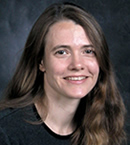 | Associate Professor Department of Microbiology and Immunology PhD., 1993, Johns Hopkins | |
| E-mail: Office: Lab: Fax: | janet.leatherwood@stonybrook.edu (631) 632-9644 (631) 632-9652 (631) 632-9797 | |
| Research | Correct cell cycle regulation is essential to prevent carcinogenesis. Mis-regulation of the cell cycle can allow uncontrolled growth and division and can also cause genome instability. Resulting genetic changes may further promote proliferation and metastisis. Cell Cycle regulation governs genome replication, packaging, and gene expression. The cell cycle itself is controlled by the cyclin dependent kinase Cdc2 (also called Cdk1). We are using the simple eukaryote S. pombe as a model system to determine how cell cycle controls regulate genome structure, DNA replication, and gene expression. High throughput approaches and S. pombe microarrays allow us to ask questions genome-wide. Current projects can be divided into three subjects areas: 1) Cell Cycle Transcription Circuits, 2) Regulation of DNA Replication Control, and 3) Regulation of Gene Expression in the Meiotic Cell Cycle.
1) Cell Cycle Transcription Circuits: Relevance: S. pombe is an excellent choice for the kind of comprehensive and global analysis proposed here. It has been and continues to be a major tool for study of the eukaryotic cell cycle and therefore will provide further insights for understanding human cell cycle regulation and how that program is altered in disease and oncogenesis. Want to see the cell cycle transcript profile for your favorite gene? Please visit http://www.redgreengene.com/oliva_plos_2005/index.html where you can access all the datasets published in Oliva et al, 2005 and you can view data gene by gene. 2) Regulation of DNA Replication Control: 3) Regulation of Gene Expression in the Meiotic Cell Cycle:
Want to know what transcripts or elevated in your favorite mutant? The resources of our microarray facility are available at cost to any not for profit research lab worldwide . We have spotted DNA microarrays for S. pombe and S. cerevisiae and will gladly process cell pellets to purify RNA, make labeled sample, hybridize to arrays, grid images and make data available along with analysis tools. Similar sample processing, hybridization, and data collection can also be carried out in our facility for high density microarray platforms from Agilent and Affymetrix. Please e-mail Janet Leatherwood ( mailto:jleatherwood@ms.cc.sunysb.edu">jleatherwood@ms.cc.sunysb.edu, or Bruce Futcher (bfutcher@ms.cc.sunysb.edu) for more information. | |

